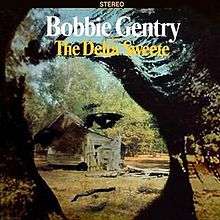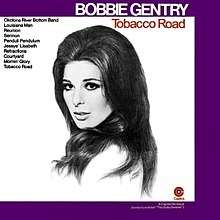The Delta Sweete
| The Delta Sweete | ||||
|---|---|---|---|---|
 | ||||
| Studio album by Bobbie Gentry | ||||
| Released | February 5, 1968 | |||
| Studio |
Capitol Recording Studio (Hollywood, CA) | |||
| Genre | Country, pop, blue-eyed soul | |||
| Length | 33:37 | |||
| Label | Capitol | |||
| Producer | Kelly Gordon | |||
| Bobbie Gentry chronology | ||||
| ||||
| Way Down South | ||||
 Cover art of the 1972 UK reissue. | ||||
| Singles from The Delta Sweete | ||||
| Professional ratings | |
|---|---|
| Review scores | |
| Source | Rating |
| Allmusic | |
The Delta Sweete is the second studio album by American singer-songwriter Bobbie Gentry. It was released on February 5, 1968, by Capitol Records.
The album was reissued in the US in 1971 by Capitol Records under the title Tobacco Road. This release omits the tracks "Big Boss Man" and "Parchman Farm", reorders the track listing and features new cover art. The album was reissued in the UK in 1972 by EMI's budget label mfp, under the title Way Down South, featuring the original track listing and new cover art.
In 2006, Australian label Raven Records released the album on CD for the first time, paired with 1968’s Local Gentry.
In 2007, the album was made available for digital download.
Content
The Delta Sweete is a concept album based on modern life in the Deep South. Gentry wrote eight of the album's 12 tracks, which detail her Mississippi childhood and includes vignettes of home and church life ("Reunion" and "Sermon"), as well as recollections of blues and country hits she heard as a youngster ("Big Boss Man" and "Tobacco Road"). The song "Okolona River Bottom Band", accented by a sophisticated horn chart and breathy strings, used the same basic cadence as "Ode to Billie Joe".
Recording sessions for the album emphasized the unique sound of Gentry's guitar picking and her singing and phrasing styles.[6] The prevailing sound on the album was a swampy, folk-tinged combination of blues and country, with uptown touches like strings and horns seemingly added to reflect the then modern styles of soul music and the Nashville sound.
Critical reception
In the issue dated February 17, 1968, Billboard published a review that said, "Although Bobbie Gentry's last album skyrocketed to the top of the albums chart, this one is not going to even approach that one in sales. However, Miss Gentry has built up a reputation and her singing is fine. So this package should still have respectable sales. The music, written mostly by Miss Gentry, is essentially country and is performed in a good country style."[7]
Cashbox also published a review on February 17, saying, "It must have been difficult for Bobbie Gentry to keep her head amidst the adulation and fame that were showered upon her as a result of her million-selling single, "Ode to Billie Joe", but she has survived the storm and her second album is better than her first. Eight of the songs on the set are her own compositions, and they show her to be an effective ballad writer as well as a skillful portrayer of the life of the Mississippi Delta country."[8]
In the February 17, 1968 issue of Record World a review was published which focused more on Gentry's physical appearance than the music, saying, "As Frank Sinatra defines it, a very sexy broad is what makes the world go 'round. Bobbie Gentry certainly would make a red-blooded man agree. She's Earth Mother, Cleopatra, Stella and not Opehlia, Venus or Blache. Eeyow. "Okolona" and other rock candy."[9]
Commercial performance
The album peaked at No. 132 on the U.S. Billboard Top LP's chart.
The album’s first single, "Okolona River Bottom Band", was released in November 1967. It peaked at No. 54 on the US Billboard Hot 100 chart, and at No. 49 in Canada on the RPM Top Singles chart.
Released in March 1968, the second single, "Louisiana Man", peaked at No 23 on Australia's Kent Music Report Singles Chart, No. 72 on the US Billboard Hot Country Singles chart, and No. 100 on the US Billboard Hot 100 chart.
In May 1968, "Refractions" and "Big Boss Man", were released in Japan and France, respectively. Both singles failed to chart.
Track listing
All tracks written by Bobbie Gentry, except as noted.
Original release (1968), Way Down South (1972)
| Side one | ||
|---|---|---|
| No. | Title | Length |
| 1. | "Okolona River Bottom Band" | 2:57 |
| 2. | "Big Boss Man" (Luther Dixon, Al Smith) | 2:56 |
| 3. | "Reunion" | 2:35 |
| 4. | "Parchman Farm" (Mose Allison) | 3:00 |
| 5. | "Mornin' Glory" | 2:57 |
| 6. | "Sermon" | 2:41 |
| Side two | ||
|---|---|---|
| No. | Title | Length |
| 1. | "Tobacco Road" (John D. Loudermilk) | 2:57 |
| 2. | "Penduli Pendulum" | 2:56 |
| 3. | "Jessye' Lisabeth" | 2:35 |
| 4. | "Refractions" | 3:00 |
| 5. | "Louisiana Man" (Doug Kershaw) | 2:57 |
| 6. | "Courtyard" | 2:41 |
Tobacco Road (1971)

| Side one | ||
|---|---|---|
| No. | Title | Length |
| 1. | "Okolona River Bottom Band" | 2:57 |
| 2. | "Louisiana Man" (Doug Kershaw) | 2:57 |
| 3. | "Reunion" | 2:35 |
| 4. | "Mornin' Glory" | 2:57 |
| 5. | "Sermon" | 2:41 |
| Side two | ||
|---|---|---|
| No. | Title | Length |
| 1. | "Tobacco Road" (John D. Loudermilk) | 2:57 |
| 2. | "Penduli Pendulum" | 2:56 |
| 3. | "Jessye' Lisabeth" | 2:35 |
| 4. | "Refractions" | 3:00 |
| 5. | "Courtyard" | 2:41 |
Personnel
Adapted from the album liner notes.
- Bobbie Gentry - vocals
- Kelly Gordon - producer
- Jimmie Haskell - arrangements
- Shorty Rogers - arrangements
Chart positions
Album
| Year | Chart | Chart position |
| 1968 | US Top LP's (Billboard)[10] | 132 |
Singles
| Year | Single | Chart | Chart position |
| 1968 | "Okolona River Bottom Band" | Canada Top Singles (RPM) | 49 |
| US Hot 100 (Billboard)[11] | 54 | ||
| "Louisiana Man" | Australia (Kent Music Report) | 23 | |
| US Hot Country Singles (Billboard)[12] | 72 | ||
| US Hot 100 (Billboard)[13] | 100 |
References
- ↑ "Bobbie Gentry - Okolona River Bottom Band". Retrieved 10 June 2018.
- ↑ "Bobbie Gentry - Louisiana Man". Retrieved 10 June 2018.
- ↑ "Bobbie Gentry - Refractions". Retrieved 19 September 2018.
- ↑ "Bobbie Gentry - Big Boss Man". ultratop.be. Retrieved 19 September 2018.
- ↑ Allmusic review
- ↑ Thom Jurek. "The Delta Sweete/Local Gentry". Billboard.com.
- ↑ "Billboard Magazine - February 17, 1968" (PDF). American Radio History. Billboard Magazine. Retrieved 13 June 2018.
- ↑ "Cashbox Magazine - February 17, 1968" (PDF). American Radio History. Cashbox Magazine. Retrieved 26 September 2018.
- ↑ "Record World - February 17, 1968" (PDF). American Radio History. Record World. Retrieved 27 September 2018.
- ↑ "Bobbie Gentry Chart History". Billboard. Retrieved 12 June 2018.
- ↑ "Bobbie Gentry Chart History". Billboard. Billboard Magazine. Retrieved 7 June 2018.
- ↑ "Bobbie Gentry Chart History". Billboard. Billboard Magazine. Retrieved 7 June 2018.
- ↑ "Bobbie Gentry Chart History". Billboard. Billboard Magazine. Retrieved 7 June 2018.